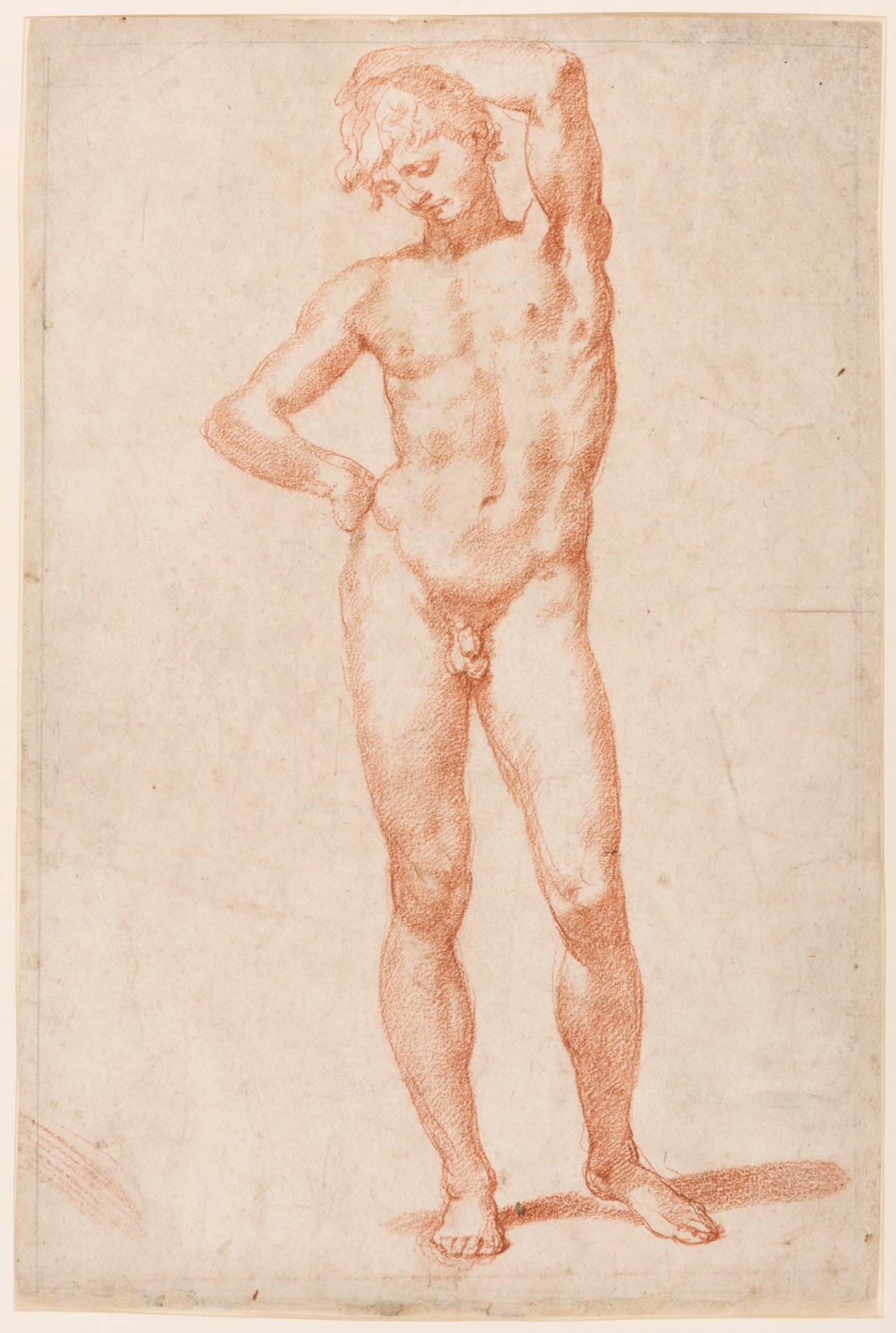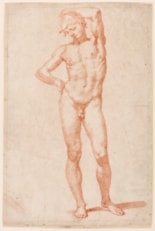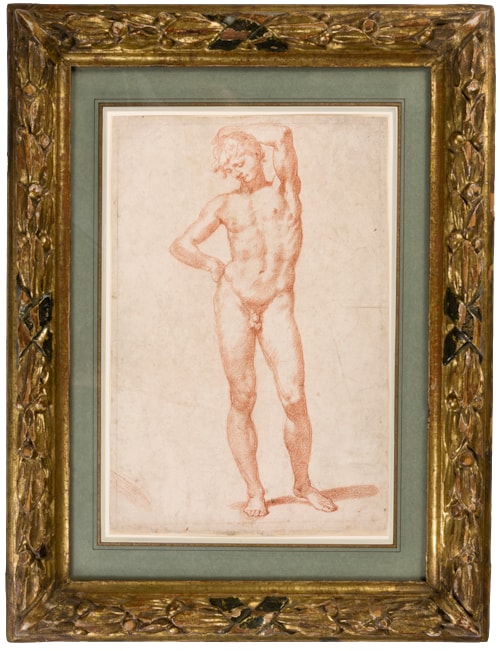SANTI DI TITO
(Sansepolcro 1536 - Florence 1603)
A Standing Male Nude
Red chalk.
365 x 242 mm. (14 3/8 x 9 1/2 in.)
365 x 242 mm. (14 3/8 x 9 1/2 in.)
This 'studi dal vero' of a male nude may be classed among those drawings, numbering almost two hundred sheets, described in the 1603 inventory of Santi du Tito's studio as figure studies drawn from life (‘Centonovantasei disegni al naturale in mezzi fogli di mano di Santi Titi’) and intended as academic exercises. As Julian Brooks has noted, ‘The real engine-room of life drawing in Florence seems to have been the studio of Santi di Tito…Santi and his pupils re-asserted the earlier Renaissance practice of making studies for each of the figures in a painting, and furthermore regularly drew from life as an exercise…Yet the sessions of life drawing in Santi’s studio were fairly informal. It is recorded that Cigoli, while he was working with the architect Bernardo Buontalenti, went to Santi’s studio ‘every day to draw from life, benefitting in the rendering of poses.’’.
In his account of the artist’s career, Baldinucci reserved particular praise for Santi di Tito’s life drawings, of which he owned several, noting that ‘there come…from his hand an infinite number of drawings of particularly natural nudes…[which] are so marvellously proportioned, they are set on the page thus by design, so that the head can be placed at the summit of the page, with no waste or need for extra paper, just sufficient…to draw a very fine line.’ Santi’s drawings of male nudes are characterized by firm contours and a delicate play of light and shadow across the forms of the body.
While most of the artist’s studies of male nudes were drawn in black chalk, a number of fine examples in red chalk are known, with which the present sheet may be stylistically compared. These include a Standing Male Nude and a Study of a Nude Young Boy, both in the Uffizi, as well as three red chalk drawings of male nudes in the Louvre, which would appear to be studies of the same curly-haired model depicted on the present sheet. All of these drawings can be dated to the artist’s early maturity, in the decade of the 1570s.
In his account of the artist’s career, Baldinucci reserved particular praise for Santi di Tito’s life drawings, of which he owned several, noting that ‘there come…from his hand an infinite number of drawings of particularly natural nudes…[which] are so marvellously proportioned, they are set on the page thus by design, so that the head can be placed at the summit of the page, with no waste or need for extra paper, just sufficient…to draw a very fine line.’ Santi’s drawings of male nudes are characterized by firm contours and a delicate play of light and shadow across the forms of the body.
While most of the artist’s studies of male nudes were drawn in black chalk, a number of fine examples in red chalk are known, with which the present sheet may be stylistically compared. These include a Standing Male Nude and a Study of a Nude Young Boy, both in the Uffizi, as well as three red chalk drawings of male nudes in the Louvre, which would appear to be studies of the same curly-haired model depicted on the present sheet. All of these drawings can be dated to the artist’s early maturity, in the decade of the 1570s.
One of the leading artists of the Counter Reformation in Florence, Santi di Tito played an important role in the transition from Mannerism to the Baroque in the city. According to the Florentine biographer Filippo Baldinucci, the young Santi left his native town of Sansepolcro to study in Florence with Agnolo Bronzino and Baccio Bandinelli. Apart from six early years in Rome, between 1558 and 1564, he was to spend most of his career in Florence, where he painted numerous altarpieces for local churches that, in their emphasis on clarity of form and narrative content, served to challenge the excesses of the earlier generation of Mannerist painters. Among his early works are three paintings for the Studiolo of Francesco I de’ Medici in the Palazzo Vecchio, painted between 1570 and 1572, which look somewhat out of place next to the more Mannerist works of the artist’s contemporaries in the same small room. Among several works painted for Florentine churches may be noted two altarpieces in Santa Croce, a Resurrection of Christ and a Supper at Emmaus, both completed around 1574, as well as five lunette frescoes for the Chiostro Grande of Santa Maria Novella, painted between 1572 and 1582, and a Vision of Saint Thomas Aquinas for San Marco, executed in 1593. Santi also provided altarpieces for churches elsewhere in Tuscany, notably for the Duomo in his native Sansepolcro in c.1577, as well as another for Santo Stefano dei Cappuccini in nearby Arezzo, painted in 1601.
Santi di Tito was a committed and very active member of the Florentine Accademia del Disegno throughout his career, and up until his death in 1603. His success as a painter led to the establishment of a flourishing studio, where he held informal life-drawing classes that were popular among younger Florentine artists. Indeed, his influence among his many students (including Andrea Boscoli, Agostino Ciampelli, Ludovico Cigoli, Gregorio Pagani and Cosimo Gamberucci), ensured that his Reformist style dominated the work of the succeeding generation of painters in Florence.
A talented and prolific draughtsman, Santi di Tito was, according to his biographer Baldinucci, ‘tanto innamorato di questa bella facoltà di disegno’, and worked in a variety of media, techniques and styles. Baldinucci goes on to note that the artist spent all his spare time making drawings - including, as he writes, studies of his wife, his children, the maidservant, the footstools and even the cat - and indeed a recently discovered inventory of the contents of Santi’s house and studio, taken just after his death in 1603, list more than seven hundred drawings. A significant number of Santi’s drawings were purchased by Baldinucci from the artist’s grandson and are now in the collection of the Uffizi in Florence, which today houses the largest number of drawings by the artist, amounting to some 250 sheets. Other significant groups of drawings by Santi di Tito are in the Louvre in Paris and the Istituto Nazionale per la Grafica in Rome.
Santi di Tito was a committed and very active member of the Florentine Accademia del Disegno throughout his career, and up until his death in 1603. His success as a painter led to the establishment of a flourishing studio, where he held informal life-drawing classes that were popular among younger Florentine artists. Indeed, his influence among his many students (including Andrea Boscoli, Agostino Ciampelli, Ludovico Cigoli, Gregorio Pagani and Cosimo Gamberucci), ensured that his Reformist style dominated the work of the succeeding generation of painters in Florence.
A talented and prolific draughtsman, Santi di Tito was, according to his biographer Baldinucci, ‘tanto innamorato di questa bella facoltà di disegno’, and worked in a variety of media, techniques and styles. Baldinucci goes on to note that the artist spent all his spare time making drawings - including, as he writes, studies of his wife, his children, the maidservant, the footstools and even the cat - and indeed a recently discovered inventory of the contents of Santi’s house and studio, taken just after his death in 1603, list more than seven hundred drawings. A significant number of Santi’s drawings were purchased by Baldinucci from the artist’s grandson and are now in the collection of the Uffizi in Florence, which today houses the largest number of drawings by the artist, amounting to some 250 sheets. Other significant groups of drawings by Santi di Tito are in the Louvre in Paris and the Istituto Nazionale per la Grafica in Rome.
Provenance
Anonymous sale, Milan, Sotheby’s, 22 June 2004, lot 6
Jean-Luc Baroni Ltd., London, in 2005
Private collection, London.
Jean-Luc Baroni Ltd., London, in 2005
Private collection, London.
Exhibition
New York, Jean-Luc Baroni Ltd. at Adam Williams Fine Art Ltd., and London, Jean-Luc Baroni Ltd., Master Drawings and Oil Sketches, 2005, no.4.





